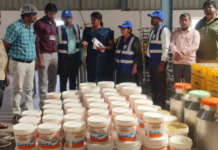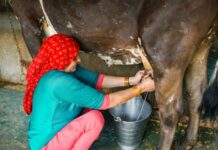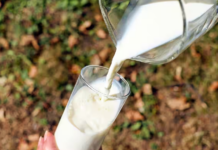- Dairy farmers are using fans to help keep cows comfortable but milk production may still take hit.
- Some chicken producers sent birds to market early to beat the heat but may pay for it with lighter weights.
- Nut and citrus growers took urgent measures to avoid crop loss.
New Delhi, June 30, 2017: A stifling June heatwave with triple-digit temperatures hit agriculture producers in California, lowering dairy cow milk production and wreaking havoc on crops like citrus and nuts according to cnbc.com.
Dairy production can fall as much as 20 percent on days when the mercury hits the triple digits. There’s also been some reports of scorched grapes in some places as well as what’s known as regreening of Valencia oranges.
“As far as we can tell at this point, it hasn’t been a huge problem although there will be some impacts almost certainly,” said Dave Kranz, a spokesman for the California Farm Bureau Federation.
According to reports published in cnbc.com for producers of nuts and citrus, the heat brought on a critical need to add more water or take other steps to reduce the threat of heat stress, which can make trees vulnerable to insects and damage crops.
One bit of good news this summer is the heavy winter rains put the final nail in the coffin for the state’s six-year drought and means there’s plenty of water for farmers to irrigate their crops. Last year, some farmers were still seeing water cutbacks and would have been forced to pay high prices in many cases for extra water to offset the heat.
“We’ve got plenty of water,” said Chuck Dirske, an almond farmer in Denair, located in the state’s Central Valley. “We’re just keeping the trees as irrigated as they need to be.”
Among the state’s hottest regions in the recent heatwave is the San Joaquin Valley, where the bulk of agriculture takes place in California. The state’s huge snow melt also is causing some rivers and dams to fill up in the Central Valley where there’s been several levee breaks and flooding in some farm communities along the Kings River as well as reports of some crops such as alfalfa going under water.
“We happen to be a county with flood warnings now because of a significant amount of snowpack that’s coming off the Sierra Nevada,” said Ryan Jacobsen, CEO of the Fresno County Farm Bureau and a grower of wine grapes.
Last week, temperatures in the Central Valley reached around 110 degrees or above and dairy cows had to handle night temperatures in the 80s or low 90s.
“Dairy farmers and poultry people have taken a lesson from July of 2006 when there was a horrible heatwave and we lost dairy cows and poultry,” said Kranz. “They put in different equipment to help protect their animals and to get through this” cnbc.com further added.
Last week, dairy farmers were using huge cooling fans through cow barns and some were relying on mist systems to try to bring the temperatures down inside the facilities and corals leading up to milk stations. Some dairies also shifted schedules to cooler parts of the day to protect cows and workers from the worst heat of the day.
Even so, dairy production is likely to be lower as cows produce less milk during extremely hot weather. California produces about one-fifth of the nation’s milk supply, according to the U.S. Department of Agriculture.
“There’s been some recovery in the milk on the cows but basically we took a 20 percent hit when we had those 5 to 6 days of 109 to 112 degrees,” said Tom Barcellos, a dairy producer in the Central Valley.
Added Barcellos, “Everybody has cooling facilities, whether it’s fans or misters or something like that. But they (cows) are no different than we are. You stand out there in the shade and it’s still hot.”
He said dairy farmers should be able to handle the declines for a few days because milk prices are stable and “up a little bit from where they were years back. Feed prices have come down a little bit. It makes it a little more tolerable.”
As for poultry, the state farm bureau’s Kranz said some of the chicken producers sent their birds to market “a little bit early” ahead of the heat. “They may have lost a little bit in terms of the value of those birds because their weights are down.”
California Poultry Federation president Bill Mattos said most of the chicken facilities in the state are in air-conditioned buildings so they handled the heatwave “pretty good.” He said some smaller turkey producers might have been affected “a little bit.”
The USDA’s California Crop Weather report issued Monday also showed farmers were scrambling to avoid crop damage.
Specifically, USDA said “walnut growers applied sunburn preventative materials” to protect them during days of the scorching heat. Walnuts are particularly vulnerable to sunburn but coating the trees with the functional equivalent of sunscreen allows them to handle the hot temperatures with less stress.
Additionally, the government said citrus “regreening has become more common due to the higher temperatures.” Regreening occurs when the heat causes parts of the orange’s pigment to get tinges of green.
Usually regreening occurs in July and August when the heat is most intense. That said, farmers can put the harvested fruit into control rooms where ethylene gas naturally emitted by the citrus helps correct the issue.
If the regreening isn’t corrected, though, it can sometimes result in the citrus getting rejected for overseas shipment to the higher-margin export business and kept in the domestic market. Some years exports have accounted for as much as 25 percent of California’s orange volume, mostly to Asian countries such as Japan, China and South Korea.
At the same time, if citrus trees are not watered enough to compensate for the extreme heat, there can be a loss of crop. At present, there are two crops on the Valencia summer orange trees, both immature fruit that bloomed in April and May as well as and ripening fruit.
“If the growers don’t keep their groves heavily watered, then next year’s crop will start falling off the tree,” said Joel Nelsen, president of the California Citrus Mutual, a citrus producers trade group representing about 75 percent of the state’s citrus industry.
There were some reports that the heat wave was scorching some grapes grown in the Central Valley for wine or raisins. But growers further north in the Napa Valley appear to be fine for now despite the high temperatures up around 108 degrees some days due to double-digit humidity levels. Heat also can slow down grape development.
Meantime, the heatwave broke over the weekend in many agricultural areas in California and temperatures are now are in the upper 90s. However, weather forecasters predict later in the week it will heat up again and be back in the triple digits.
“It will be another Pacific Northwestern heatwave first,” said USDA meteorologist Brad Rippey. “Then as we move into especially Friday, Saturday and Sunday, and looking into next week, another round of extreme heat for most areas of the West.”
Rippey also said the long-range guidance from the U.S. government’s Climate Prediction Center is for a “three-month outlook indicating a pretty strong likelihood of above normal temperatures in the Pacific Coast states, the Great Basin and the Southwest, which lines up pretty strikingly where the extreme heat has been over the last week plus.”

























